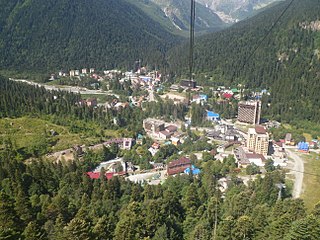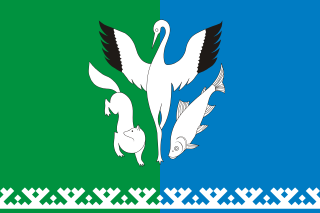
Karachay-Cherkessia, officially the Karachay-Cherkess Republic, is a republic of Russia located in the North Caucasus. It is administratively part of the North Caucasian Federal District. As of the 2021 census, Karachay-Cherkessia has a population of 469,865. Cherkessk is the largest city and the capital of the republic.

Cherkessk is the capital city of Karachay-Cherkessia, Russia, as well as its political, economic, and cultural center. Population: 129,069 (2010 Russian census).

Stavropol Krai, also known as Stavropolye, is a federal subject of Russia. It is geographically located in the North Caucasus region in Southern Russia, and is administratively part of the North Caucasian Federal District. Stavropol Krai has a population of 2,907,593, according to the 2021 Census.

Krasnodar Krai is a federal subject of Russia, located in the North Caucasus region in Southern Russia and administratively a part of the Southern Federal District. Its administrative center is the city of Krasnodar. The third most populous federal subject, the krai had a population of 5,838,273 as of the 2021 Census.

Tyumen Oblast is a federal subject of Russia. It is located in Western Siberia, and is administratively part of the Urals Federal District. The oblast has administrative jurisdiction over two autonomous okrugs: Khanty-Mansi Autonomous Okrug and Yamalo-Nenets Autonomous Okrug. Tyumen Oblast, including its autonomous okrugs, is the third-largest federal subject by area, and has a population of 3,395,755 (2010).

The Nenets Autonomous Okrug is a federal subject of Russia and an autonomous okrug of Arkhangelsk Oblast. Its administrative center is the town of Naryan-Mar. It has an area of 176,700 square kilometers (68,200 sq mi) and a population of 42,090 as of the 2010 Census, making it the least populous federal subject.

Khanty-Mansi Autonomous Okrug–Yugra, commonly shortened to Khantia-Mansia, is a federal subject of Russia. It has a population of 1,532,243 as of the 2010 Census. It's administrative center is located at Khanty-Mansiysk.

Autonomous okrugs are a type of federal subject of the Russian Federation and simultaneously an administrative division type of some federal subjects. As of 2024, Russia has four autonomous okrugs of its 83 federal subjects. The Chukotka Autonomous Okrug is the only okrug which is not subordinate to an oblast. The Nenets Autonomous Okrug is a part of Arkhangelsk Oblast, the Khanty-Mansi Autonomous Okrug and the Yamalo-Nenets Autonomous Okrug are parts of Tyumen Oblast.

The federal subjects of Russia, also referred to as the subjects of the Russian Federation or simply as the subjects of the federation, are the constituent entities of Russia, its top-level political divisions according to the Constitution of Russia. Kaliningrad Oblast is the only federal subject geographically separated from the rest of the Russian Federation by other countries.
Ust-Dzheguta is a town and the administrative center of Ust-Dzhegutinsky District of the Karachay–Cherkess Republic, Russia, located north of the Caucasus Mountains on the right bank of the Kuban River 15 kilometers (9.3 mi) south of Cherkessk. Population: 31,137 (2021 Census); The dam here is the start of the Great Stavropol Canal.

Labytnangi is a town in Yamalo-Nenets Autonomous Okrug, Russia, located on the left bank of the Ob River, 20 kilometers (12 mi) northwest of Salekhard. Population: 26,936 (2010 Russian census); 27,304 (2002 Census); 31,501 (1989 Soviet census).

Gubkinsky is a town in Yamalo-Nenets Autonomous Okrug, Russia, located on the left bank of the Pyakupur River, south of Salekhard. Population: 23,335 (2010 Russian census); 20,407 ; 9,676.

Russia, the largest country in the world, has international land borders with fourteen sovereign states as well as 2 narrow maritime boundaries with the United States and Japan. There are also two breakaway states bordering Russia, namely Abkhazia and South Ossetia. The country has an internationally recognized land border running 22,407 kilometres (13,923 mi) in total, and has the second-longest land border of any country in the world, after China. The borders of the Russian Federation were mostly drawn since 1956, and have remained the same after the dissolution of the Soviet Union. In 2014, Russia annexed Ukraine's Crimean peninsula in a move that remains internationally unrecognized.

Dombay is an urban locality under the administrative jurisdiction of the town of republic significance of Karachayevsk in the Karachay-Cherkess Republic, Russia. As of the 2010 Census, its population was 657.

Northern Krai was an administrative-territorial unit (krai) of the Russian SFSR from 1929 to 1936. Its seat was in the city of Arkhangelsk. The krai was located in the north of European Russia, and its territory is currently divided between Arkhangelsk, Vologda, Kostroma, and Kirov Oblasts, the Nenets Autonomous Okrug, and the Komi Republic.

Shuryshkarsky District is an administrative and municipal district (raion), one of the seven in Yamalo-Nenets Autonomous Okrug of Tyumen Oblast, Russia. It is located in the southwest of the autonomous okrug. The area of the district is 54,016 square kilometers (20,856 sq mi). Its administrative center is the rural locality of Muzhi. Population: 9,814 ; 9,559 (2002 Census); 9,001 (1989 Soviet census). The population of Muzhi accounts for 36.8% of the district's total population.

Yamalsky District is an administrative and municipal district (raion), one of the seven in Yamalo-Nenets Autonomous Okrug of Tyumen Oblast, Russia. It is located in the north and northwest of the autonomous okrug. The area of the district is 117,410 square kilometers (45,330 sq mi). Its administrative center is the rural locality of Yar-Sale. Population: 16,310 ; 14,918 (2002 Census); 15,029 (1989 Soviet census). The population of Yar-Sale accounts for 39.8% of the district's total population.
Elbrussky is an urban locality under the administrative jurisdiction of the town of republic significance of Karachayevsk in the Karachay-Cherkess Republic, Russia. As of the 2010 Census, its population was 320.

Separatism in Russia refers to bids for secession or autonomy for certain federal subjects or areas of the Russian Federation. Historically there have been many attempts to break away from the Russian Empire and the Soviet Union but modern separatism took shape in Russia after the Dissolution of the Soviet Union and the annexation of Crimea. Separatism in modern Russia was at its biggest in the 1990s and early 2000s. The topic became relevant again after the 2022 Russian invasion of Ukraine. The primary causes of separatism are nationalism in the republics, economic dependency, and geographic isolation. The promotion of separatism is illegal in Russia.























